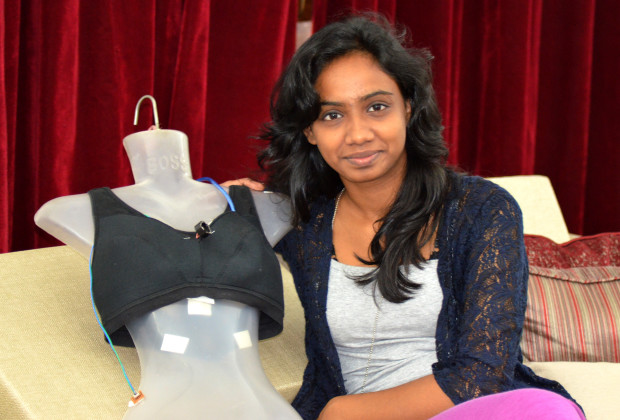Nearly two years ago, the gruesome gang rape and murder of a young woman on a bus in New Delhi left many Indians shocked and saddened. Tens of thousands took to the streets of the capital, urging the government to act.
Eventually, lawmakers passed stringent new anti-rape legislation. But for some concerned citizens like Manisha Mohan, changing the law wasn’t enough. The 22-year-old engineering student wanted to give women a way to defend themselves against attackers, something that went beyond mace, pepper spray or mixed martial arts. So over the past year, Mohan and two of her fellow students developed a rape-repellent bra that can shock and burn attackers.
Manisha Mohan and her fellow students came up with the idea for the rape-repellent bra after the Delhi gang rape in 2012.
It’s called Society Harnessing Equipment, or SHE for short, and here’s how it works: The bra contains a pressure sensor connected to an electric circuit that generates a shock of 3,800 kilovolts, which is severe enough to stun an attacker and severely burn his hand.
“It won’t be enough to immobilize the assailant or potential rapist,” Mohan says, “but that gives enough time for back up.”
The moment its pressure sensors are activated, the bra’s built-in GPS also alerts the police and the victim’s parents to the location where the attack is taking place.
SHE- Society Harnessing Equipmen inventors Recieving their Gandhian Young Technological Innovation Award
Mohan, right, and her partners receive an award for their invention in New Delhi.
False alarms are possible, but Mohan says the bras are designed and calibrated to prevent this. The force of a hug, for instance, won’t create a shock, and there’s an on and off switch that a woman can use when she’s traveling through a dangerous neighborhood.
Those who have worn the bra say it’s comfortable. “It is light like any other bra, and one really cannot [tell] a difference,” says a young woman, who asked not to be named.
Mohan is still fine-tuning the sensors, so she hasn’t decided when she’ll start shipping the bras to stores or how much they’ll cost. But the timing seems right. Reports of crimes against women in India, such as rape, murder and kidnapping, increased by 26 percent last year compared with the previous one.
Not only does the bra send an electric shock, but it also alerts the police.
A bra, of course, may not actually drive down the number of attacks against women; many attacks occur in India’s rural hinterland, where few are likely to be able to afford it. But in a country that has a dubious record of ensuring women’s safety, Mohan and others think the device can help.
“My dream,” Mohan says, “is to see women walk free anywhere and anytime.”

